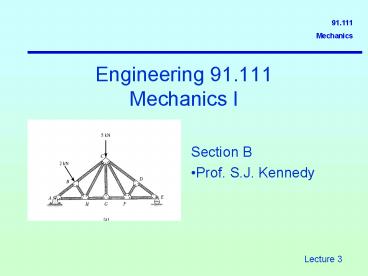Engineering 91.111 Mechanics I - PowerPoint PPT Presentation
1 / 17
Title:
Engineering 91.111 Mechanics I
Description:
Make additional sketches to clarify problem solution ... Be NEAT! Show significant digits. Final answers 3 or 4 digits. Intermediate results to 4 or 5 ... – PowerPoint PPT presentation
Number of Views:99
Avg rating:3.0/5.0
Title: Engineering 91.111 Mechanics I
1
Engineering 91.111Mechanics I
- Section B
- Prof. S.J. Kennedy
2
Course Information
TEXT. Engineering Mechanics. Statics and Dynamics
8th Ed. R.C. Hibbeler. Prentice-Hall
1998.
INSTRUCTOR 91.111B Prof. S.J. Kennedy
3064 MC
Ph. 520-5793
LECTURES 91.111B Theatre B
Monday 1130 AM
Tuesday 130 PM
Thursday 1230
PM
PROBLEM ANALYSIS 230 PM to 530 PM
First hour Instruction Second
hour Q/A Third hour Test
3
Course Information (cont.)
4
Solution Presentation
- Simple statement of problem
- Include sketch where applicable
- State assumptions
- Make additional sketches to clarify problem
solution - Simple geometric calculations to the right of
sketch
5
Solution Presentation (cont.)
- State Principles and show formulae
- indicate results of intermediate steps
- Repeat final answers near the right edge, under
or beside the final step - Mark it clearly as the answer
- Use the following
- Pencil
- Eraser
- Straightedge
6
Solution Presentation (cont.)
- Be NEAT!
- Show significant digits
- Final answers 3 or 4 digits
- Intermediate results to 4 or 5
- Show units of measure
- Use Quad (engineering) paper
7
Example Solution
8
Introduction
- Mechanics of rigid bodies
- Statics acted on by balanced forces and are at
rest or have uniform motion. - Kinematics concerned with the motion of bodies
without considering the manner in which the
motion is produced. - Kinetics concerned with bodies that are acted
on by unbalanced forces and have non-uniform or
accelerated motions.
9
Introduction (cont.)
- Mechanics of deformable bodies
- Mechanics of fluids
10
Newtons Laws of Motion
- Law 1
- In the absence of external forces, a particle
originally at rest or in motion with a constant
velocity will remain at rest or continue to move
with a constant velocity along a straight line
11
Newtons Laws of Motion
- Law 2
- If an external force acts on a particle, the
particle will be accelerated in the direction of
the force and the magnitude of the acceleration
will be directly proportional to the force and
inversely proportional to the mass of the
particle. - Fma
12
Newtons Laws of Motion
- Law 3
- For every action there is an equal and opposite
reaction. The forces of action and reaction
between contacting bodies are equal in magnitude,
opposite in direction, and collinear. - From this Newton formulated the Law of
Gravitation, the law that governs the mutual
attraction between two isolated bodies.
13
Newtons Laws of Motion
- Where
- F is the magnitude of the mutual force of
attraction between the two bodies - G is the universal gravitational constant
6.673x10-11 m3/kgs2
m2
m1
r
F Gm1m2/r2
14
Mass and Weight
- Mass (m, units kg.) of a body is an absolute
quantity and is independent of the position of
the body. - Weight (W, units N.) of a body is the
gravitational attraction exerted on the body by
another body such as the earth.
WGmem/re
- Where
- me is the mass of the earth
- re is the mean radius of the earth
15
Units of Measurement
16
Units of Measurement
- Derived units include area, volume,linear or
angular velocity, acceleration, frequency,
density, force, stress, pressure, etc. - Engineers express
- linear measurements in mm.
- Force in KN.
- Stress and Pressure in MPa.
17
Additional Material
- Read Sections 1.1-1.6
- Problems Section 1
- 1,8,13,15,16































